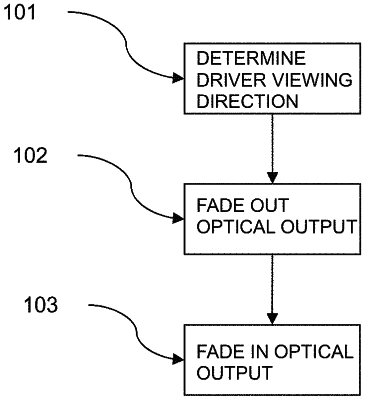| CPC G09G 3/002 (2013.01) [B60K 35/00 (2013.01); G06F 3/013 (2013.01); G06V 40/18 (2022.01); B60K 2370/149 (2019.05); B60K 2370/1529 (2019.05); B60K 2370/21 (2019.05); B60K 2370/33 (2019.05); G09G 2320/0626 (2013.01); G09G 2340/14 (2013.01); G09G 2354/00 (2013.01); G09G 2380/10 (2013.01)] | 9 Claims |

|
1. A method for controlling an optical output of image data on an output device in a vehicle, the method comprising:
determining, in the vehicle, a viewing direction of a driver of the vehicle;
fading out, responsive to determining that the viewing direction of the driver of the vehicle is directed to the output device, the optical output of the image data with an average fading out rate DOWN, wherein the fading out rate DOWN defines a temporal decrease in the optical perceptibility of the output image data by a human; and
fading in, responsive to determining that the viewing direction of the driver is directed towards the output device and then is directed away from the output device, the optical output of the image data with an average fading in rate UP, wherein the fading in rate UP defines a temporal increase of the optical perceptibility of the output image data by the human, the method further comprising
determining a frequency at which the viewing direction of the driver is directed towards the output device or the viewing direction of the driver is directed away from the output device, wherein the fading out rate DOWN is increased or the fading in rate UP is reduced as the determined frequency increases.
|